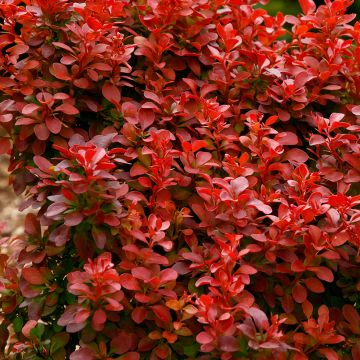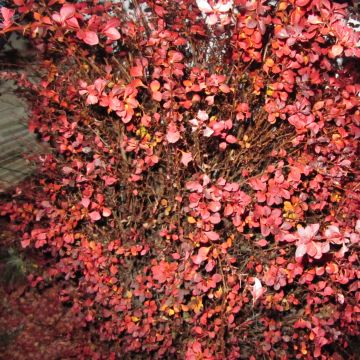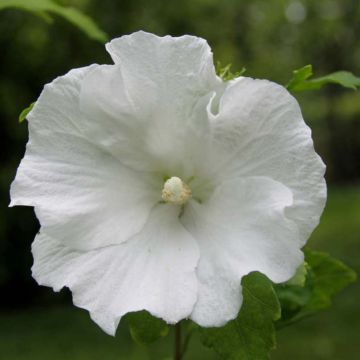

Berberis thunbergii - Barberry


Berberis thunbergii - Barberry


Berberis thunbergii - Barberry


Berberis thunbergii - Barberry


Berberis thunbergii - Barberry


Berberis thunbergii - Barberry
View more pictures
Hide images

Louis-Jean L.

Louis-Jean L. • BE
Berberis thunbergii - Barberry
Berberis thunbergii
Japanese Barberry
The photo is misleading. This berberis is not purple as the photo suggests, it remains green! Nonetheless, it has recovered well despite the scorching summer.
Anne, 31/10/2022
Special offer!
Receive a €20 voucher for any order over €90 (excluding delivery costs, credit notes, and plastic-free options)!
1- Add your favorite plants to your cart.
2- Once you have reached €90, confirm your order (you can even choose the delivery date!).
3- As soon as your order is shipped, you will receive an email containing your voucher code, valid for 3 months (90 days).
Your voucher is unique and can only be used once, for any order with a minimum value of €20, excluding delivery costs.
Can be combined with other current offers, non-divisible and non-refundable.
Home or relay delivery (depending on size and destination)
Schedule delivery date,
and select date in basket
This plant carries a 24 months recovery warranty
More information
We guarantee the quality of our plants for a full growing cycle, and will replace at our expense any plant that fails to recover under normal climatic and planting conditions.
Would this plant suit my garden?
Set up your Plantfit profile →
Description
Berberis thunbergii is an excellent bush for hedges, both highly resistant and almost impenetrable. In autumn, it is adorned with a beautiful foliage. The foliage of this barberry, more or less deciduous or evergreen depending on the climate, hides tangled branches covered with small thorns. It evolves from spring green, speckled with pale yellow flowers, to orange before turning scarlet red in autumn. Its small bright red berries remain decorative for a long time and are a delight for birds in winter. It is one of those indestructible bushes that know how to combine usefulness with pleasure!
Berberis thunbergii, also known as Thunberg's Barberry or Japanese Barberry, is a bush from the Berberidaceae family, originally from Japan, as its name suggests. It is characterised by a bushy, spreading and low habit, and deciduous or almost evergreen foliage in mild climates.
It bears a bushy, rounded and very dense habit, even spreading and drooping, barely wider than tall, reaching an average of 1.5 m (4.9 ft) in all directions. The slightly arched branches bear mildly aggressive thorns. The flowering is quite abundant in April-May in the form of drooping clusters composed of 1 to 6 small flowers. The bell-shaped flowers measure 1 cm (0.4 in) long, and are a pale and somewhat dull yellow, streaked with faded red. They appear on the previous year's shoots, carried by reddish peduncles. They are nectar-rich flowers that are appreciated by pollinating insects. They are followed in September-October by small, very bright red spherical fruits. They measure from 6 mm to 8 mm (0.2 in to 0.3 to in) in length and persist throughout part of the winter. The foliage of this Berberis emerges green in spring, becomes more orange in summer and turns bright red in autumn. The small leaves measure from 1 cm to 3 cm (0.4 in to 1.2 in) in length, and are obovate (ovate, with the upper part of the leaf wider than the lower part). When the plant is not sufficiently exposed to sunlight, the summer and autumn colours are less pronounced.
Berberis thunbergii is ideal for medium-sized hedges, whether they are free-growing or trimmed. Its thorns and density of its vegetation also allow it to be used in a defensive hedge, combined with European or Provence gorse (Ulex parviflorus), Japanese quinces, holly, rugosa roses, and firethorns. It can also be planted in shrub borders, with forsythias and dwarf abelias (Abelia 'Kaleidoscope', 'Petite Garden'), lilacs from the 'Bloomerang' series, and loropetalums.
Report an error about the product description
Berberis thunbergii - Barberry in pictures






Plant habit
Flowering
Foliage
Botanical data
Berberis
thunbergii
Berberidaceae
Japanese Barberry
Southeast Asia
Other Berberis - Barberries
View all →Planting and care
Berberis thunbergii thrives in full sun or partial shade, with colours being more intense in the sun. It tolerates drought and harsh winters once established. Plant it in any type of soil as long as it is well-drained. During planting, the planting hole should be twice the size of the root ball. Space the Berberis about 40 cm (15.7 in) apart. Add compost and water generously. It tolerates pruning very well. From June to August, after flowering, prune the faded branches to the level of young lateral shoots to encourage the arrival of new branches. Be careful not to touch the branches with bare hands as they have thorns that are difficult to remove once they penetrate the skin. Berberis thunbergii can be susceptible to powdery mildew and black leaf spots. Aphids can invade it.
Planting period
Intended location
Care
-
, onOrder confirmed
Reply from on Promesse de fleurs
Similar products
Haven't found what you were looking for?
Hardiness is the lowest winter temperature a plant can endure without suffering serious damage or even dying. However, hardiness is affected by location (a sheltered area, such as a patio), protection (winter cover) and soil type (hardiness is improved by well-drained soil).

Photo Sharing Terms & Conditions
In order to encourage gardeners to interact and share their experiences, Promesse de fleurs offers various media enabling content to be uploaded onto its Site - in particular via the ‘Photo sharing’ module.
The User agrees to refrain from:
- Posting any content that is illegal, prejudicial, insulting, racist, inciteful to hatred, revisionist, contrary to public decency, that infringes on privacy or on the privacy rights of third parties, in particular the publicity rights of persons and goods, intellectual property rights, or the right to privacy.
- Submitting content on behalf of a third party;
- Impersonate the identity of a third party and/or publish any personal information about a third party;
In general, the User undertakes to refrain from any unethical behaviour.
All Content (in particular text, comments, files, images, photos, videos, creative works, etc.), which may be subject to property or intellectual property rights, image or other private rights, shall remain the property of the User, subject to the limited rights granted by the terms of the licence granted by Promesse de fleurs as stated below. Users are at liberty to publish or not to publish such Content on the Site, notably via the ‘Photo Sharing’ facility, and accept that this Content shall be made public and freely accessible, notably on the Internet.
Users further acknowledge, undertake to have ,and guarantee that they hold all necessary rights and permissions to publish such material on the Site, in particular with regard to the legislation in force pertaining to any privacy, property, intellectual property, image, or contractual rights, or rights of any other nature. By publishing such Content on the Site, Users acknowledge accepting full liability as publishers of the Content within the meaning of the law, and grant Promesse de fleurs, free of charge, an inclusive, worldwide licence for the said Content for the entire duration of its publication, including all reproduction, representation, up/downloading, displaying, performing, transmission, and storage rights.
Users also grant permission for their name to be linked to the Content and accept that this link may not always be made available.
By engaging in posting material, Users consent to their Content becoming automatically accessible on the Internet, in particular on other sites and/or blogs and/or web pages of the Promesse de fleurs site, including in particular social pages and the Promesse de fleurs catalogue.
Users may secure the removal of entrusted content free of charge by issuing a simple request via our contact form.
The flowering period indicated on our website applies to countries and regions located in USDA zone 8 (France, the United Kingdom, Ireland, the Netherlands, etc.)
It will vary according to where you live:
- In zones 9 to 10 (Italy, Spain, Greece, etc.), flowering will occur about 2 to 4 weeks earlier.
- In zones 6 to 7 (Germany, Poland, Slovenia, and lower mountainous regions), flowering will be delayed by 2 to 3 weeks.
- In zone 5 (Central Europe, Scandinavia), blooming will be delayed by 3 to 5 weeks.
In temperate climates, pruning of spring-flowering shrubs (forsythia, spireas, etc.) should be done just after flowering.
Pruning of summer-flowering shrubs (Indian Lilac, Perovskia, etc.) can be done in winter or spring.
In cold regions as well as with frost-sensitive plants, avoid pruning too early when severe frosts may still occur.
The planting period indicated on our website applies to countries and regions located in USDA zone 8 (France, United Kingdom, Ireland, Netherlands).
It will vary according to where you live:
- In Mediterranean zones (Marseille, Madrid, Milan, etc.), autumn and winter are the best planting periods.
- In continental zones (Strasbourg, Munich, Vienna, etc.), delay planting by 2 to 3 weeks in spring and bring it forward by 2 to 4 weeks in autumn.
- In mountainous regions (the Alps, Pyrenees, Carpathians, etc.), it is best to plant in late spring (May-June) or late summer (August-September).
The harvesting period indicated on our website applies to countries and regions in USDA zone 8 (France, England, Ireland, the Netherlands).
In colder areas (Scandinavia, Poland, Austria...) fruit and vegetable harvests are likely to be delayed by 3-4 weeks.
In warmer areas (Italy, Spain, Greece, etc.), harvesting will probably take place earlier, depending on weather conditions.
The sowing periods indicated on our website apply to countries and regions within USDA Zone 8 (France, UK, Ireland, Netherlands).
In colder areas (Scandinavia, Poland, Austria...), delay any outdoor sowing by 3-4 weeks, or sow under glass.
In warmer climes (Italy, Spain, Greece, etc.), bring outdoor sowing forward by a few weeks.


















































